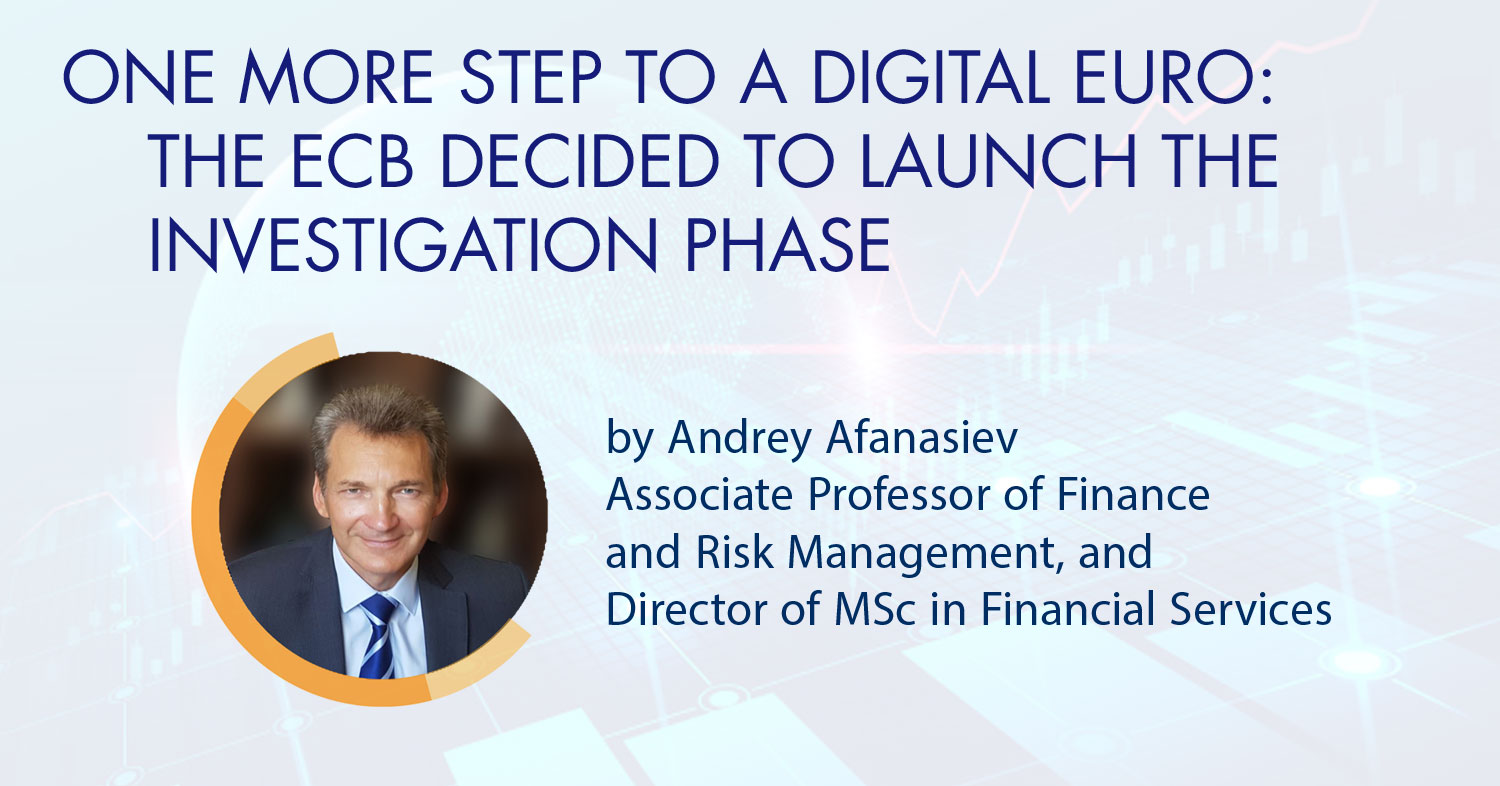The future of finance is digital. The digital transformation of finance becomes a dominant trend, which will bring many fundamental changes. One of the aspects of this trend is the way we pay in daily life. In response to changes in society and technology, as well as due to the coronavirus (COVID-19) pandemic we are increasingly buying (and as a result paying) online, i.e., digitally. The role of cash (banknotes) in payments is declining.
A digital euro is a new form of euros, which would complement the current euros, not replace them. The purpose of the digital euro introduction is to provide Europeans with a new, simple, universally accepted, safe, and trusted means of payment.
The Governing Council of the European Central Bank (ECB) decided to launch the investigation phase of a digital euro project. This investigation phase will start in October 2021 and last for about 2 years. The investigation phase aims to address key issues regarding the design and circulation of a digital euro, which should become a riskless, accessible, and efficient form of digital central bank money.
A final decision on whether to issue a digital euro is to be made at the end of the investigation phase. In case of a positive decision, a developing phase will start. The developing stage could take around 3 years. Thus, a digital euro might appear in 5 years from now.
Online payments bring important benefits such as convenience, speed, and efficiency. But they also pose technical challenges, as well as challenges in terms of privacy, safety, and accessibility.
Designing a new form of central bank money will involve defining operational and technological requirements and identifying the preferable options. Among important design features are the following: the digital euro ledger, privacy, and anti-money laundering (AML), limits on digital euro in circulation, and end-user access.
With regards to the digital euro ledger, both the Eurosystem TARGET Instant Payment Settlement (TIPS), which is based on a centralized ledger and alternatives such as blockchain, which are based on distributed ledger technology (DLT), were proven capable of processing more than 40,000 transactions per second. Architectures combining centralised and decentralised elements are also possible. It should be noted that even if a digital euro is based on a distributed ledger technology, it still will be a central bank digital currency, not a crypto asset.
The investigation phase will also shed light on the changes to the EU legislative framework which might be needed. Finally, the investigation phase will assess the possible impact of a digital euro on the market, identifying the design options to ensure privacy and avoid risks for euro area citizens, merchants, intermediaries, and the overall economy. One of the challenges is that the overall amount of a digital euro in circulation (i.e., recorded in the systems of intermediaries or end-user devices) might not match Eurosystem records. Such discrepancies could be potentially triggered by an error or misconduct of a participant.
The ECB works on the project in cooperation with other central banks. To date, in the U.S. no decision has been made on whether to issue a digital dollar. However, the Federal Reserve System remains fully engaged in central bank digital currency research and policy development.
The Peoples Bank of China (PBOC) started a digital currency project in 2014. So far, the top-level design, function development, system testing has been completed, and the PBOC has initiated pilot programs in some representative regions. A progress report, published by PBOC, is mainly focused on motivations and the monetary policy implications of the project and keeps some technical underpinnings unclear.
Meanwhile, the following features can be highlighted:
- e-CNY is the fiat currency issued by the central bank (PBOC).
- e-CNY and physical RMB will coexist (both are the PBOC’s liabilities to the public, with the same legal status and economic value).
- e-CNY adopts a centralized management model and a two-tier operational system (the PBOC issues e-CNY to commercial banks and manages e-CNY through its whole life cycle).
- e-CNY follows the principle of “anonymity for small value and traceable for high value”.
- digital wallets are the medium of e-CNY that reaches out to users (the PBOC makes the rules, while authorized operators jointly develop and share apps on mobile devices).
- e-CNY obtains programmability from deploying smart contracts that don’t impair its monetary functions.
- e-CNY adopts a variety of technologies (digital certificate system, digital signature, and encrypted storage) to make unfeasible double-spending, illegal duplication, counterfeit, etc.
What could be concluded from the above? It is obvious that we are moving to a digital world and still many challenges need to be addressed in this way. An introduction of a digital euro (or other digital currencies) will have important implications for daily life, but it is just one of the upcoming digital innovations. The matter of the digital transformation in the EU to be followed up!
About the Author
Dr Andrey Afanasiev
Associate Professor of Finance and Risk Management, the Director of the MSc in Financial Services
CIIM – Cyprus International Institute of Management


